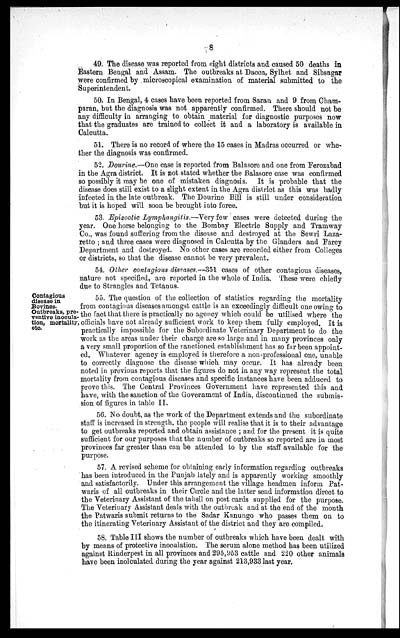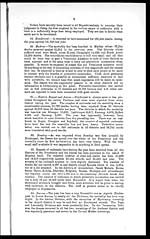Medicine - Veterinary > Civil Veterinary Departments > Annual administration report of the Civil Veterinary Department of India > 1907-1908 > Part A - Provincial administration
(19) Page 8
Download files
Individual page:
Thumbnail gallery: Grid view | List view

8
49. The disease was reported from eight districts and caused 50 deaths in
Eastern Bengal and Assam. The outbreaks at Dacca, Sylhet and Sibsagar
were confirmed by microscopical examination of material submitted to the
Superintendent.
50. In Bengal, 4 cases have been reported from Saran and 9 from Cham-
paran, but the diagnosis was not apparently confirmed. There should not be
any difficulty in arranging to obtain material for diagnostic purposes now
that the graduates are trained to collect it and a laboratory is available in
Calcutta.
51. There is no record of where the 15 cases in Madras occurred or whe-
ther the diagnosis was confirmed.
52. Dourine.—One case is reported from Balasore and one from Ferozabad
in the Agra district. It is not stated whether the Balasore case was confirmed
so possibly it may be one of mistaken diagnosis. It is probable that the
disease does still exist to a slight extent in the Agra district as this was badly
infected in the late outbreak. The Dourine Bill is still under consideration
but it is hoped will soon be brought into force.
53. Epizootic Lymphangitis.—Very few cases were detected during the
year. One horse belonging to the Bombay Electric Supply and Tramway
Co., was found suffering from the disease and destroyed at the Sewri Laza-
retto ; and three cases were diagnosed in Calcutta by the Glanders and Farcy
Department and destroyed. No other cases are recorded either from Colleges
or districts, so that the disease cannot be very prevalent.
54. Other contagious diseases.—351 cases of other contagious diseases,
nature not specified, are reported in the whole of India. These were chiefly
due to Strangles and Tetanus.
Contagious
disease in
Bovines.
Outbreaks, pre-
ventive inocula-
tion, mortality,
etc.
55. The question of the collection of statistics regarding the mortality
from contagious diseases amongst cattle is an exceedingly difficult one owing to
the fact that there is practically no agency which could be utilised where the
officials have not already sufficient work to keep them fully employed. It is
practically impossible for the Subordinate Veterinary Department to do the
work as the areas under their charge are so large and in many provinces only
a very small proportion of the sanctioned establishment has so far been appoint-
ed. Whatever agency is employed is therefore a non-professional one, unable
to correctly diagnose the disease which may occur. It has already been
noted in previous reports that the figures do not in any way represent the total
mortality from contagious diseases and specific instances have been adduced to
prove this. The Central Provinces Government have represented this and
have, with the sanction of the Government of India, discontinued the submis-
sion of figures in table II.
56. No doubt, as the work of the Department extends and the subordinate
staff is increased in strength, the people will realise that it is to their advantage
to get outbreaks reported and obtain assistance ; and for the present it is quite
sufficient for our purposes that the number of outbreaks so reported are in most
provinces far greater than can be attended to by the staff available for the
purpose.
57. A revised scheme for obtaining early information regarding outbreaks
has been introduced in the Punjab lately and is apparently working smoothly
and satisfactorily. Under this arrangement the village headmen inform Pat-
waris of all outbreaks in their Circle and the latter send information direct to
the Veterinary Assistant of the tahsil on post cards supplied for the purpose.
The Veterinary Assistant deals with the outbreak and at the end of the month
the Patwaris submit returns to the Sadar Kanungo who passes them on to
the itinerating Veterinary Assistant of the district and they are compiled.
58. Table III shows the number of outbreaks which have been dealt with
by means of protective inoculation. The serum alone method has been utilized
against Rinderpest in all provinces and 295,953 cattle and 220 other animals
have been inolculated during the year against 213,933 last year.
Set display mode to: Large image | Zoom image | Transcription
Images and transcriptions on this page, including medium image downloads, may be used under the Creative Commons Attribution 4.0 International Licence unless otherwise stated. ![]()
| Permanent URL | https://digital.nls.uk/75509483 |
|---|




